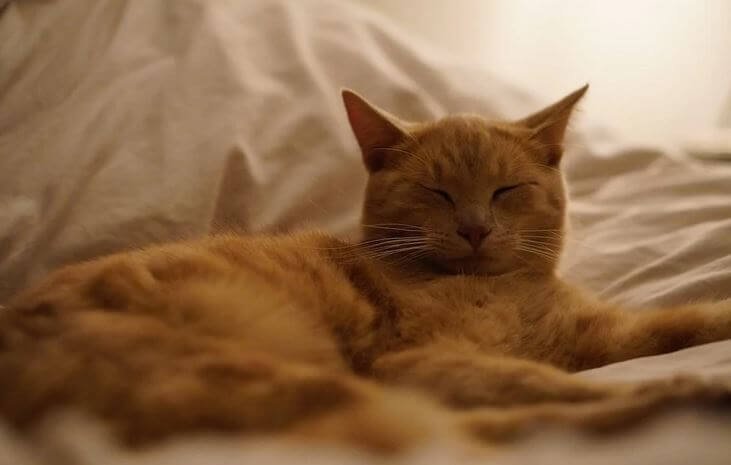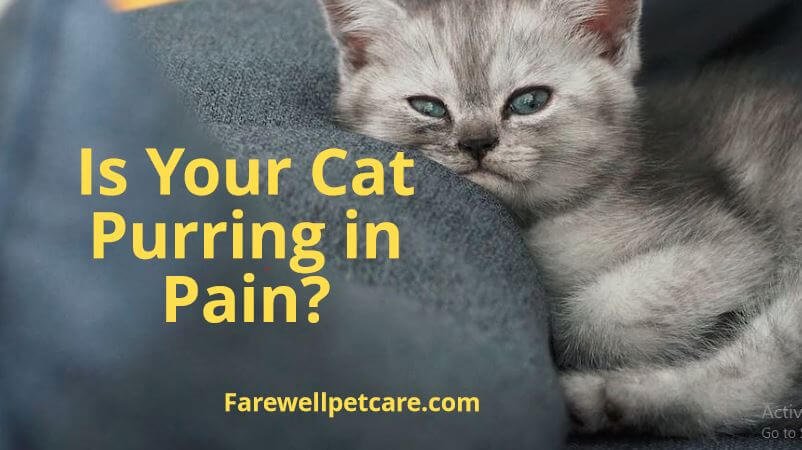Every cat owner is familiar with the soothing and rhythmic murmur of their pet’s purr. Purring is mainly associated with feelings of contentment and pleasure, although cats also purr to soothe themselves when in pain. If you are worried about the latter, some signs can help you know how to tell if a cat is purring in pain.
You can tell if a cat is purring in pain if you also notice other symptoms of disease or injury like lethargy, reduced activity, and lack of appetite. Although purring in pleasure and pain sound the same, an ache purr always tags along with behavioral changes.
Read on as we outline three guiding factors that can help tell if your furry friend is purring in pain. We will also share tips to help comfort your pet and nurse him back to optimal health.
Let’s get started!
3 Guiding Factors to Determine If Your Cat Is Purring In Pain
Cats produce a purring sound when they inhale and exhale. Their larynx muscles dilate and tighten the area around the glottis (vocal cords), which causes air passing over the laryngeal muscles to vibrate.
Often, cats produce this unique vibrato when they are happy and enjoying a petting session, the afternoon sun, or a deep connection with their owners. If you pet your cat as it nestles on your lap, you should be able to feel and hear the purring vibrations.
Oddly, cats also purr when in pain during kittenbearing and when dying. The purring sound has a consistent pattern and frequency of 25 and 150 Hertz during inhalation and exhalation.
Research shows that the purr frequency corresponds to the vibrational/electrical frequencies employed in treating pain, bone fractures, wounds, joint strains, etc.
Cats purr when in pain for the following reasons:
- To trigger the release of endorphins to help them cope with the discomfort
- Purring lowers blood pressure, decreases stress levels, and eases labored breathing
- Vibration therapy (low-frequency purring vibration) helps relieve pain
- Vibration therapy accelerates the healing of wounds, bones, and tendons.
As a responsible pet parent, worrying whether your furry friend is purring in pain or pleasure is customary. Generally, you should also notice any of the following signs if your pet is injured or ill and needs a vet’s attention.
A cat in pain is likely to be more vocal than usual.
Also Read: Cat on Antibiotics Not Eating: 5 Causes and Remedies
1. Excessive Vocalization

Besides purring more frequently or for longer durations, he may meow excessively to get your attention. You can tell that your furry friend is in severe pain if he also hisses or growls when you approach or try to initiate petting.
2. Changes in Daily Routines
An illness or injury can cause moderate to significant changes in your cat’s daily routines. For instance, your pet may seem restless and pace around because he finds it uncomfortable to lie down. He may also repeatedly lie down and wake up without straying too far from his favorite napping spot.
Moreover, an illness or injury can cause a drastic decrease in appetite and energy. You can tell your cat is lethargic if you notice the following symptoms.
- Generally withdrawn attitude even toward family members
- Reluctance in engaging in play sessions
- Decreased activities and endurance
- Reluctance to go up or down the stairs
- Messy coat caused by decreased self-grooming
- Reduced alertness and responsiveness to surroundings
Find Out: What Happens to Bonded Cats When One Dies? 6 Ways to Help Your Cat
3. Behavioral Changes
Cats, like humans, can display behavioral changes when unwell. Pain often causes changes in sleep patterns, and your furry friend may refuse to sleep and instead lie down with his eyes wide open. Some cats may also squint to seem half asleep or gaze into space without drifting.
Furthermore, a cat in pain may have an odd facial expression. He will seem to be frowning and may also show uncharacterized aggression when approached. Depending on the source of pain and its degree, some cats lash out and assume a defensive posture when their owners try to handle them.
If you suspect your feline friend is purring in pain, you should bring the matter to your vet’s attention. Whether the source of aches is a disease or an injury, it will be easier to treat or manage if caught early. The correct care will give your pet the maximum chance of returning to his former lively self.
How to Comfort a Cat Purring in Pain—4 Effective Ways

Comforting a cat purring in pain can be challenging, especially if you hardly understand the underlying cause of the concern. It is always better to consult a vet to understand your pet’s health status fully.
The following tips will come in handy when comforting your purring cat:
1. Observe Your Cat’s Behavior
The first and most crucial step to comforting your cat is to recognize his pain and suffering.
Pay close attention to your cat’s behavioral changes because some may not be as apparent as others. Hopefully, this can help you tell whether the cause of pain is a tummy ache, a bee sting, or something more severe like osteoarthritis.
Also, physically examine your cat for any visible signs of injury or trauma. Part your pet’s fur and search for swollen or tender spots on the body. You can also tell the aching site if it appears inflamed or feels hot to the touch.
2. Consult a Vet for Proper Treatment and Medication
If you notice signs that your furry friend is in pain, you should consult your vet immediately. A qualified vet will run diagnostics and devise a treatment plan to ensure your pet enjoys more permanent relief.
Some of the common pain medications for cats include:
- Opioids
- N-methyl-D-aspartate (NMDA)
- Gabapentin and Monoclonal antibody (mAb)
- Non-steroidal anti-inflammatory drugs (NSAIDs)
Proper diagnosis is essential to finding the best solutions to a pain problem. Depending on the identified condition, a vet may recommend the following supplements to help manage chronic pain.
- Omega-3 fatty acids
- CBD (cannabidiol)
- Glucosamine and chondroitin sulfate
3. Provide a Comfortable Environment
Once your cat receives the proper medication, you should provide a comfortable environment to help him recuperate. Ensure your kitty has a warm, cozy bed, and place it in a spot away from noise and disruptions. If you have small kids, request them not to pester the cat as it rests.
If treatment involves a surgical procedure, you should restrict your furry friend from running and jumping for 7 to 10 days. This should allow the surgical wound to heal gracefully and minimize the risk of postoperative complications.
Here are a few tips you can use to restrict your cat’s movement:
- Consider crating your feline friend during the first few days following surgery.
- Take down the cat tree or move it to a room inaccessible to your pet.
- Ensure your kitty remains indoors throughout the recovery period.
- Isolate your cat from other resident pets to discourage jumping.
- Reduce stimuli like interactive toys to encourage your cat to lie down and relax.
4. Be Present For Your Pet As It Recovers
Cats are hardy creatures. However, your pampered furry friend can turn a little dramatic when dealing with pain. You can offer comfort by spending as much time as possible together. This should give your pet the reassurance they need to relax and focus on getting better.
Bonding triggers the release of oxytocin, which helps to reduce stress hormones. Merely being near your cat will reduce suffering and help with the recovery process.
During bonding sessions, consider massaging your cat to provide comfort and relaxation. If your vet recommends against this, gently touch your furry friend but avoid any painful or sensitive spots. You can also do passive stretching and range motion exercises, especially if the pain has rendered your pet immobile.
Your touch, like your presence, can help reduce stress and anxiety. Remember to keep an eye on your pet’s body language and refrain from any form of touch that causes discomfort.
Frequently Asked Questions
How Do Cats Express Pain?
Cats express pain through vocalization like excessive purring, meowing or yowling. Sometimes the car may display behavioral changes like lethargy, decreased grooming, hiding, and aggression. When you notice such signs, it might be a sign that your furry friend is expressing pain. Therefore, you should act as soon as possible by visiting a vet to confirm the issue.
It’s also worth mentioning that some cats my turn completely quiet when in pain. Therefore, if you notice some changes in your feline’s lifestyle, it’s recommended to visit a vet to find out the issue.
How Do You Know If Your Cat Is Uncomfortable?
You can know if your cat is uncomfortable by observing how it behaves, including body movements. You may notice the cat squinting or closing its eyes tightly. Other cats tend to flatten their ears when uncomfortable.
Final Thoughts
Purring is a form of vocalization that can help your feline friend communicate different emotions, including happiness, contentment, stress, anxiety, and pain. If you are unsure how to tell if a cat is purring in pain, we recommend scrutinizing the circumstances around a purr.
For instance, your pet is probably having the best time of his life if he is purring while curled up on your lap as you stroke him under the chin. On the other hand, you have reason to suspect pain if your kitty purrs excessively alongside displaying worrisome symptoms like reduced activity and uncharacterized aggressiveness.

